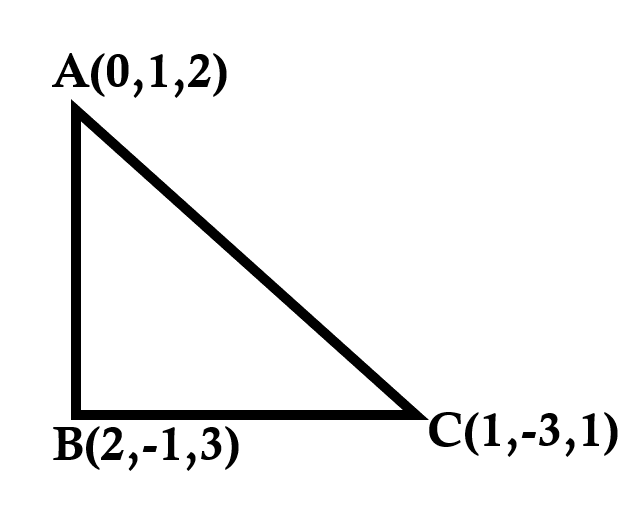
If the points (0,1,2), (2,-1,3) and (1,-3,1) are the vertices of a triangle, then the triangle is
A. Right-angled
B. Isosceles right-angled
C. Equilateral
D. None of these
Answer
217.8k+ views
Hint: Sketch a diagram and then find the distance between all three points using the distance formula given two points $P({x_1},{y_1},{z_1})\,{\text{and }}Q({x_2},{y_2},{z_2})$: \[{\text{distance}}\, = \sqrt {{{({x_1} - {x_2})}^2} + {{({y_1} - {y_2})}^2} + {{({z_1} - {z_2})}^2}} \]. Square the distances and use the Pythagoras Theorem to check whether it is a right-angled triangle.
Formula Used:
If two points $P({x_1},{y_1},{z_1})\,{\text{and }}Q({x_2},{y_2},{z_2})$ then \[PQ = \sqrt {{{({x_1} - {x_2})}^2} + {{({y_1} - {y_2})}^2} + {{({z_1} - {z_2})}^2}}\]
Pythagoras Theorem: $H^2 = B^2 + P^2$
Complete Step by step solution:

Image: Triangle ABC
Let A be (0,1,2), B be (2,-1,3) and C be (1,-3,1). Let us now find the distances AB, BC, and CA using the distance formula.
Given two points $P({x_1},{y_1},{z_1})\,{\text{and }}Q({x_2},{y_2},{z_2})$ the distance PQ is found using the following formula:
\[{\text{distance}}\, = \sqrt {{{({x_1} - {x_2})}^2} + {{({y_1} - {y_2})}^2} + {{({z_1} - {z_2})}^2}} \].
$AB = \sqrt {{{(0 - 2)}^2} + {{(1 - ( - 1))}^2} + {{(2 - 3)}^2}} = \sqrt {4 + 4 + 1} = \sqrt 9 = 3\,units$
$BC = \sqrt {{{(1 - 2)}^2} + {{( - 3 - ( - 1))}^2} + {{(1 - 3)}^2}} = \sqrt {1 + 4 + 4} = \sqrt 9 = 3\,units$
$CA = \sqrt {{{(0 - 1)}^2} + {{(1 - ( - 3))}^2} + {{(2 - 1)}^2}} = \sqrt {1 + 16 + 1} = \sqrt {18} = 3\sqrt 2 \,units$
$A{B^2} = 9\,unit{s^2}$, $B{C^2} = 9\,unit{s^2}$ and $C{A^2} = 18\,unit{s^2}$
We can see that \[A{B^2} + B{C^2} = C{A^2}\]
From the converse of Pythagoras Theorem, we can say that this is a right-angled triangle.
It is an isosceles right-angled triangle as it has two sides equal and one right angle.
Therefore, option (B) Isosceles right-angled is the correct option.
Note: The converse of Pythagoras theorem states that if the sum of squares of two sides of a triangle is equal to the square of the third side, then the triangle is a right-angled triangle. AB cannot be -3 units as it is distance and distance cannot be negative.
Formula Used:
If two points $P({x_1},{y_1},{z_1})\,{\text{and }}Q({x_2},{y_2},{z_2})$ then \[PQ = \sqrt {{{({x_1} - {x_2})}^2} + {{({y_1} - {y_2})}^2} + {{({z_1} - {z_2})}^2}}\]
Pythagoras Theorem: $H^2 = B^2 + P^2$
Complete Step by step solution:

Image: Triangle ABC
Let A be (0,1,2), B be (2,-1,3) and C be (1,-3,1). Let us now find the distances AB, BC, and CA using the distance formula.
Given two points $P({x_1},{y_1},{z_1})\,{\text{and }}Q({x_2},{y_2},{z_2})$ the distance PQ is found using the following formula:
\[{\text{distance}}\, = \sqrt {{{({x_1} - {x_2})}^2} + {{({y_1} - {y_2})}^2} + {{({z_1} - {z_2})}^2}} \].
$AB = \sqrt {{{(0 - 2)}^2} + {{(1 - ( - 1))}^2} + {{(2 - 3)}^2}} = \sqrt {4 + 4 + 1} = \sqrt 9 = 3\,units$
$BC = \sqrt {{{(1 - 2)}^2} + {{( - 3 - ( - 1))}^2} + {{(1 - 3)}^2}} = \sqrt {1 + 4 + 4} = \sqrt 9 = 3\,units$
$CA = \sqrt {{{(0 - 1)}^2} + {{(1 - ( - 3))}^2} + {{(2 - 1)}^2}} = \sqrt {1 + 16 + 1} = \sqrt {18} = 3\sqrt 2 \,units$
$A{B^2} = 9\,unit{s^2}$, $B{C^2} = 9\,unit{s^2}$ and $C{A^2} = 18\,unit{s^2}$
We can see that \[A{B^2} + B{C^2} = C{A^2}\]
From the converse of Pythagoras Theorem, we can say that this is a right-angled triangle.
It is an isosceles right-angled triangle as it has two sides equal and one right angle.
Therefore, option (B) Isosceles right-angled is the correct option.
Note: The converse of Pythagoras theorem states that if the sum of squares of two sides of a triangle is equal to the square of the third side, then the triangle is a right-angled triangle. AB cannot be -3 units as it is distance and distance cannot be negative.
Recently Updated Pages
Elastic Collision in Two Dimensions Explained Simply

Elastic Collisions in One Dimension Explained

Electric Field of Infinite Line Charge and Cylinders Explained

Electric Flux and Area Vector Explained Simply

Electric Field of a Charged Spherical Shell Explained

Electricity and Magnetism Explained: Key Concepts & Applications

Trending doubts
JEE Main 2026: Application Form Open, Exam Dates, Syllabus, Eligibility & Question Papers

Derivation of Equation of Trajectory Explained for Students

Hybridisation in Chemistry – Concept, Types & Applications

Understanding the Angle of Deviation in a Prism

Understanding Collisions: Types and Examples for Students

How to Convert a Galvanometer into an Ammeter or Voltmeter

Other Pages
JEE Advanced Marks vs Ranks 2025: Understanding Category-wise Qualifying Marks and Previous Year Cut-offs

Understanding Atomic Structure for Beginners

Ideal and Non-Ideal Solutions Explained for Class 12 Chemistry

Degree of Dissociation: Meaning, Formula, Calculation & Uses

Understanding Electromagnetic Waves and Their Importance

Understanding the Electric Field of a Uniformly Charged Ring




